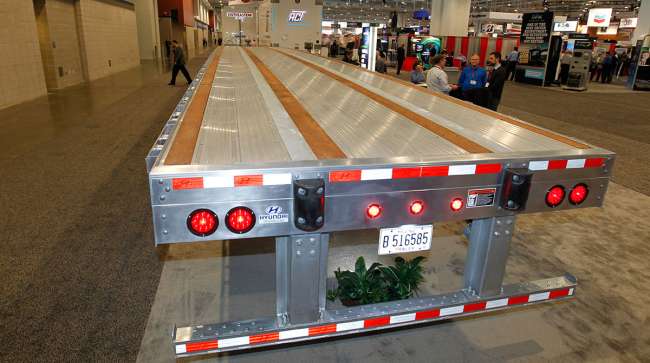Senior Reporter
FMCSA Announces Final Rule Requiring Annual Inspections of Rear Underride Guards

[Stay on top of transportation news: Get TTNews in your inbox.]
The Federal Motor Carrier Safety Administration has issued a final rule amending safety regulations to specifically add rear underride impact guards as a required item on the list of annual inspections for motor carriers and roadside inspectors.
This final rule, due to be posted in the Federal Register on Nov. 9, responds to rulemaking petitions from the Commercial Vehicle Safety Alliance, as well as a recommendation from the Government Accountability Office and comments from members of Congress.
The rule also adds a definition of road construction controlled horizontal discharge trailers and makes it clear that RCC trailers are not required to have a rear impact guard installed.
CVSA applauds Senators Gillibrand & Rubio & Congressmen Cohen & DeSaulnier for the Stop Underrides Act, which seeks to improve CMV underride protection & add underride guards to the list of parts & accessories required to be inspected under the FMCSRs. https://t.co/iwixvRbxYo — CVSA (@CVSA) March 5, 2021
The final rule requirements largely mirror the proposed rule that was announced Dec. 29, and noted that the rule should have little significant effect on most motor carriers that since 1952 have been required to install rear guards on their trucks.
“The impacts of this final rule are de minimis, and therefore, the final rule does not have a significant economic impact on a substantial number of small entities,” FMCSA said.
American Trucking Associations Vice President of Safety Policy Dan Horvath commented, “ATA is pleased that FMCSA has moved forward with improving the inspection standards for rear impact guards. Requiring these guards to be inspected on an annual basis is a step forward for safety.”
Rear impact guards and rear-end protection on most commercial vehicles reduce the incidence of passenger compartment intrusion during crashes in which a passenger vehicle strikes the rear of the CMV, FMCSA said.
Industry trade groups largely have been supportive of the new annual inspection requirement, but have opposed attempts to require side guards.
Since January 1998, trailers and semi-trailers have been in violation of federal regulations if the guards were missing or not securely attached to the trailer, including broken or missing fasteners, any welds or parent metal cracked, or other damage that compromises secure attachment.
However, CVSA noted in its petition that not all carriers are inspected annually.

In this episode, host Michael Freeze asks, how are companies saving money by leasing trucks rather than owning? For answers, we speak with Jim Lager of Penske Truck Leasing and Al Barner of strategic fleet solutions at Fleet Advantage. Hear a snippet above, and get the full program by going to RoadSigns.TTNews.com.
A vehicle’s rear impact guard/rear-end protection is inspected roadside as part of the North American Standard Inspection Program. However, the majority of commercial motor vehicles do not come into contact with an inspector on an annual basis, CVSA noted in comments.
“According to data available through FMCSA’s Analysis and Information Online webpage, in fiscal-year 2017 inspectors documented more than 2,300 violations related to rear impact guards and rear-end protection, more than half of which are for components that are missing, damaged or improperly constructed,” FMCSA said. “Including rear impact guards and rear-end protection in the periodic inspection requirements will call additional attention to this critical safety component and help ensure that each vehicle is checked at least once a year, improving compliance and helping to prevent fatalities and injuries when rear-end collisions occur.”
“Furthermore, including rear impact guards and rear-end protection in the periodic annual inspection standards will harmonize U.S. regulations with those in Canada and Mexico, which include rear impact guards and rear-end protection as part of their annual inspection programs.”
Several senators asked GAO, the office that conducts congressional investigations, to review data on truck underride crashes and information on underride guards. Between January 2018 and March 2019, GAO conducted a performance audit that included a literature review and interviews with stakeholders familiar with underride crashes and guards. GAO also interviewed stakeholders including DOT officials, industry and safety groups, and state officials.
“Although reported underride crash fatalities represent a small percentage of total traffic fatalities, they present a greater risk of fatalities or serious injuries,” said an April 2019 report released by GAO.
In comments on the proposed rear-guard rule, the Truck Trailer Manufacturers Association said that the phrase “not securely attached” in the proposal is “vague and insufficient to catch many unsafe, damaged or improperly repaired guards.”
“TTMA suggested that the inspection should not allow “broken or missing fasteners, cracked welds, corrosion that evidences any loss of original or parent material, bends that indicate prior impact damage not yet repaired or asymmetrical repairs indicating the use of non-OEM approved components,” FMCSA said.

Mooney
CVSA Executive Director Collin Mooney, in an interview when the proposal was announced, said that the rule, if finalized, would mean that a check of truck rear underride guards will become a part of the CMV inspector process.
Some CVSA inspectors do not cite a trucker when they observe a damaged or loose rear guard, Mooney said.
However, if the new regulation becomes final, “then we obviously will inspect as well,” Mooney said. “We’ll be taking a closer look at underride guards.”
Want more news? Listen to today's daily briefing below or go here for more info:




